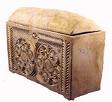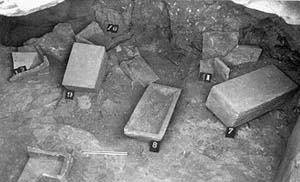- Latest Archaeology Updates
- Importance and applicability
- Famous Archaeologists
- Museums Collections
- Site Map
- World Heritage Sites
- World History Monuments
- Archaeological Organizations
- World Atlas of Archaeology
- Forensic Investigation and Geophysics
- Contact Us
- Movies based on Archaeology
- Frequently Asked Questions
- Archaeological discoveries
- Tell a Friend
- Archaeological Abbreviations
- Gallery Collections
- Famous-Museums site map
- Famous-archaeologists site map
- Archaeological Monuments site map
The Caiaphas ossuary is a first-century limestone bone box, believed to contain the remains of the High Priest and Sadducee Caiaphas, mentioned in the New Testament. The ossuary was discovered in 1990 in a tomb in the Jerusalem suburb of Talpiot. It is important because it is one of the few artifacts that may be linked directly to a figure from the New Testament. The ossuary is inscribed in Aramaic "Yehosef bar Qafa", which is thought to be a reference to Joseph Caiaphas. Caiaphas was the high priest at the time of Jesus' death, and it is thought that he may have also been responsible for his crucifixion.
In December of 1990, an exhilarating discovery astounded the world of archaeology! In the Peace Forset section of Jerusalem, a first century Ossuary, or "bone box," was found. Emblazoned on the ossuary were the words "Yehosef bar Kayafa," translated as "Joseph, son of Caiaphas." Excavator Zvi Greenhut of the Israeli ancient times Authority recovered the work of art, which is now on exhibit at the Isael Museum in Jerusalem.
Matthew, Luke and John each identify Caiaphas as the high priest that presided over the arrest and trial of Jesus. The historian Josephus also identifies "Joseph Caiaphas" as the Jewish high priest from 18 to 36 AD (Jewish Antiquities 18:35). Josephus also refers to him as "Joseph who was known as Caiaphas of the high priesthood "Caiaphas and Pontius Pilate Caiaphas had no power to inflict the sentence of death, and thus Jesus was sent to Pilate, the Roman governor, that he may accordingly pronounce the sentence against Jesus. At later era Caiaphas's antagonism to the gospel is still apparent even after the resurrection - (Acts 4:6).
The Caiaphas Ossuary, Pontius Pilate's Caesarea inscription, proof of crucifixion, and historians also naming Pilate and Caiaphas corroborate that the tale of Christ's crucifixion is by no way a fairy tale.
- The Caiaphas Ossuary is a significant archaeological find that has shed some light on the life of a prominent figure in the Bible. It is a limestone box that was discovered in 1990 and believed to have contained the remains of the high priest Caiaphas, mentioned in the New Testament.
- The ossuary is inscribed with the names of Caiaphas and his father-in-law Joseph, which confirms the involvement of the high priest in the trial and crucifixion of Jesus.
- The Caiaphas Ossuary is an important archaeological find because it is the only physical evidence that links a biblical figure to a specific object from the time of Jesus. It provides an opportunity for researchers to better understand the life and times of Caiaphas and his role in the trial and death of Jesus.
- The ossuary is made of limestone and is inscribed with the names of Caiaphas and Joseph. It is believed to date from the 1st century AD and is thought to have contained the remains of Caiaphas after his death. The inscription on the ossuary confirms that Caiaphas was a high priest in the 1st century AD and was involved in the trial and death of Jesus.
- The Caiaphas Ossuary has become a source of debate in recent years. While some scholars argue that the ossuary is genuine, others have questioned its authenticity due to the lack of archaeological evidence to support its existence.
- The debate surrounding the ossuary has brought attention to the role of Caiaphas in the trial and death of Jesus and has shed some light on the life of a prominent figure in biblical history.
- The Caiaphas Ossuary is an important archaeological find that has provided insight into the life and times of a biblical figure. It is a significant discovery that has sparked debate and has allowed researchers to better understand the role of Caiaphas in the trial and death of Jesus.
Amesbury Archer (or King of Stonehenge) is an early Bronze Age man, dating to around 2300 BC. His grave is of particular importance because of the rich valuables and the earliest gold objects ever found in England.
Otzi the Iceman is well naturally preserved mummy of a man. The man who was been captured in Ice was believed to be over 53 centuries old (3300 BC).
Java man is an interesting discovery to note that the find was not a complete specimen, but consisted merely of a skullcap, a femur, and three teeth. Many scientists of the day even suggested that Dubois' Java Man might have been the so-called "missing link
Kennewick Man is the name for the remains of a prehistoric man found on a bank of the Columbia River near Kennewick, Washington, on July 28, 1996. The Kennewick Man news story is one of the most significant archaeology stories of contemporary times.
Neandertal1 or Neanderthal was a species of genus Homo (Homo neanderthalensis) that inhabited Europe and parts of western Asia during the last ice age.
Peking Man (sometimes now called Beijing Man), also called Sinanthropus pekinensis (currently Homo erectus pekinensis), is an example of Homo erectus.
The Red Lady of Paviland is a fairly complete Upper Paleolithic-era human male skeleton dyed in red ochre, discovered in 1823 by Rev. William Buckland in one of the Paviland limestone caves of the Gower Peninsula in south Wales, dating from c29,000.
The Tollund man lived during the late 5th century BC and/or early 4th century BC, about 2,400 years . He was buried in a peat bog on the Jutland Peninsula in Denmark, a find known as a bog body.
Turkana Boy, the designation given to fossil KNM-WT (Kenya National Museum-West Turkana), is a nearly complete skeleton of a 12-year-old hominid boy who died 1.6 million years ago.Turkana Boy is classified as either Homo erectus or Homo ergaster.
The Dead Sea Scrolls are a collection of about 850 documents, including texts from the Hebrew Bible, which were discovered in eleven caves near Qumran, in a fortress northwest of the Dead Sea in Israel.
The Narmer Palette, or Great Hierakonpolis Palette, is a significant Egyptian archeological find, dating from about 3200 BC, containing some of the earliest hieroglyphic inscriptions ever found, and depicting the unification of Upper and Lower Egypt under Narmer.
Rosetta Stone is a dark granite stone (often incorrectly identified as "basalt") which provided modern researchers with translations of ancient text in Egyptian demotic script, Greek, and Egyptian hieroglyphics.
Linear B is the script that was used for writing Mycenaean, an early form of the Greek language. It occurrs primarily on tablets dated from the 14th and 13th centuries BC.
The Sweet Track is an ancient roadway in the Somerset Levels, England. As of the early 2000s, it is the oldest known engineered roadway in the world. An grand footpath that ran for almost 2km across the Somerset levels swamps.
Tautavel Man is an ancestor of Neanderthal man, was slightly different from his contemporaries living Asia and Africa. In the village of Tautavel is located in the South of France, one of the most ancient humans was found: the Tautavel Man.
The Galilee Boat which is also referred as the "Jesus Boat" was found by local Galilean inhabitants in January 1986. The boat was wrapped in a polyurethane shell and then immersed in a special tank of water to avoid quick disintegration.
The monumental Ekron inscription is dated, statistically and historically, to the first half of the seventh century B.C.E. The five lines of the inscription are together with this in a slit open border.
It wasn't long back when a lot of scholars were quizzical the real survival of a Roman Governor with the name Pontius Pilate, the procurator who ordered Jesus' crucifixion. In June 1961 close to Caesarea-on-the-Sea (Maritima) was unearthed this appealing limestone block.
In 1990 ornately decorate limestone ossuary (bone depository) was found in Jerusalem's Peace Forest. In the ossuary were the bones of two babies, a adolescent child, a teenage boy, an adult woman, and a man about 60years of age.
In biblical Israel, papyrus was the main form of writing substance. Once an authorized deed was written, it would be rolled up, one end crinkled in one-third of the width and the contrary end likewise folded in.
It is the Capital city of a prehistoric principality in what these days is on the northern part of the Syrian coast, just north of the city of Latakia.


